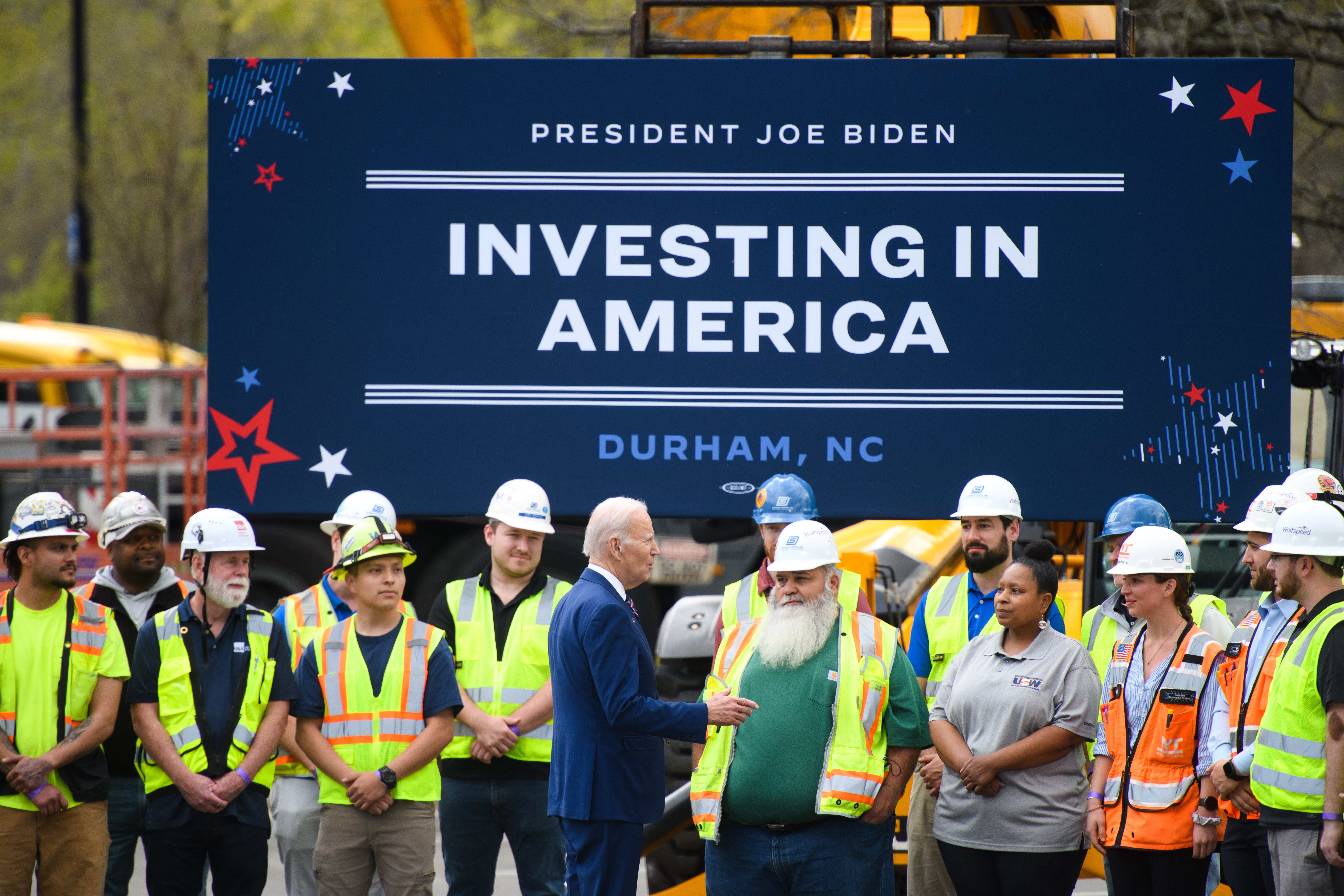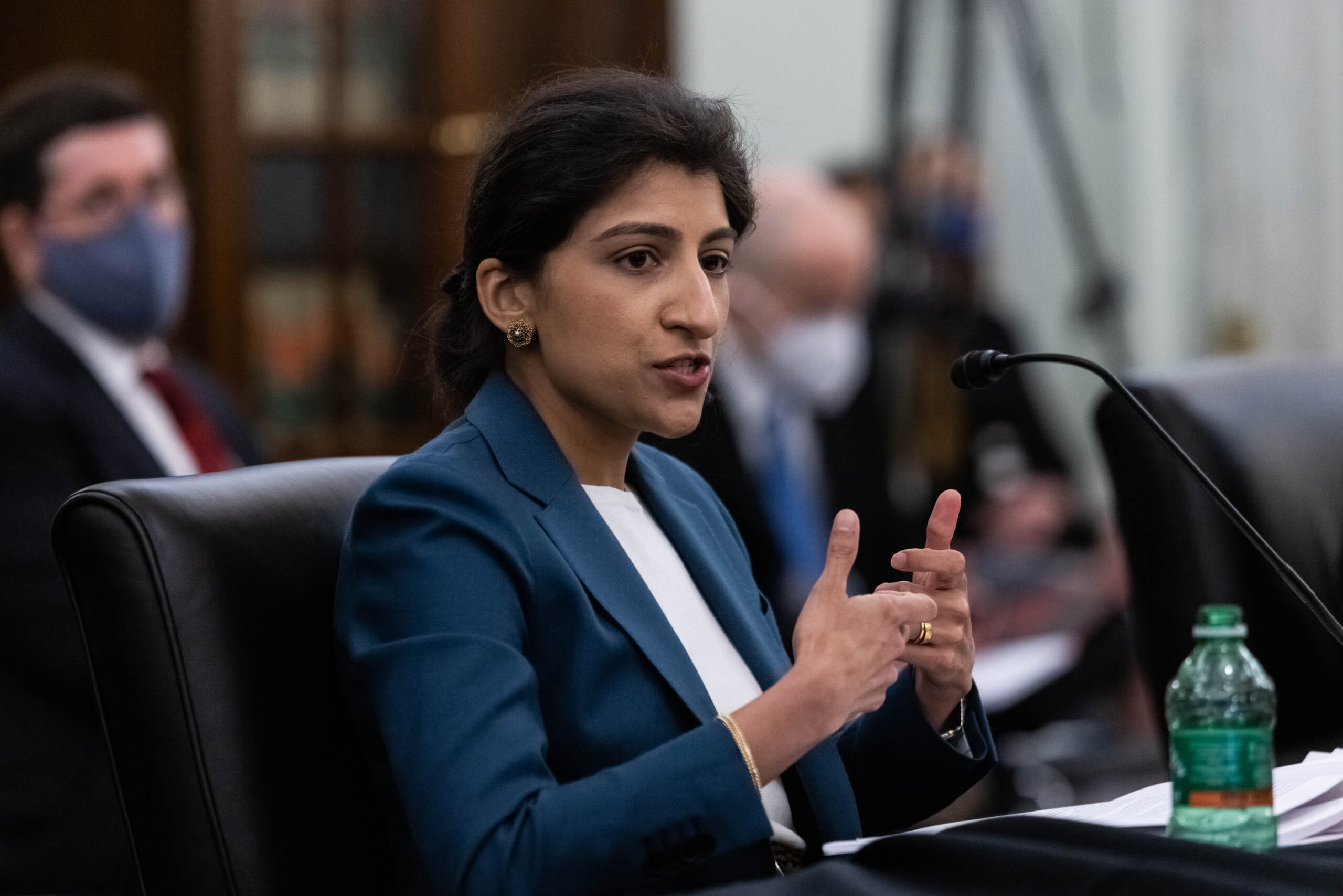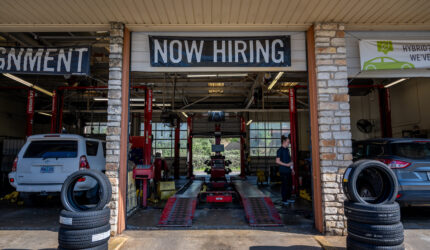Sea Change: How a New Economics Went Mainstream
November 16, 2023
By Felicia Wong, Suzanne Kahn, Mike Konczal, Matt Hughes
In this report, we seek to offer an analysis of the people, institutions, and history that brought us to this moment in economic policymaking. From the Green New Deal, to the American Rescue Plan, we look at key economic moments and what has been accomplished and what remains to be done if we are to see a sustained transition toward more progressive economic governance.
Introduction
When President Biden took office in January of 2021, old ways of economic thinking had been in decline for at least a decade—a slow transformation hastened by the cataclysmic events of 2020. Years of slow growth and financial chaos following the 2008 financial crisis had led philanthropic leaders, policymakers, and politicians to question the credibility of the economic paradigm that had dominated for almost half a century: neoliberalism.
Neoliberalism had touted the idea of “free” and apolitical markets while using government policy to structure them, in service of maximizing individual returns and minimizing costs, and at the expense of public investment (Friedman 1962).
In 2011, Occupy Wall Street activists drew attention to the false promises and economic failures of that approach, spotlighting rising inequality and calling for a rebalancing of power in our economy.1 Over the following 10 years, academic theorists and policy researchers joined grassroots activists in beginning to articulate how to do exactly that. Increasingly, the ideas generated from across the progressive movement called into question core beliefs about market primacy and individualism—ideas that had guided policymaking in the US since the 1970s, regardless of which party was in power.
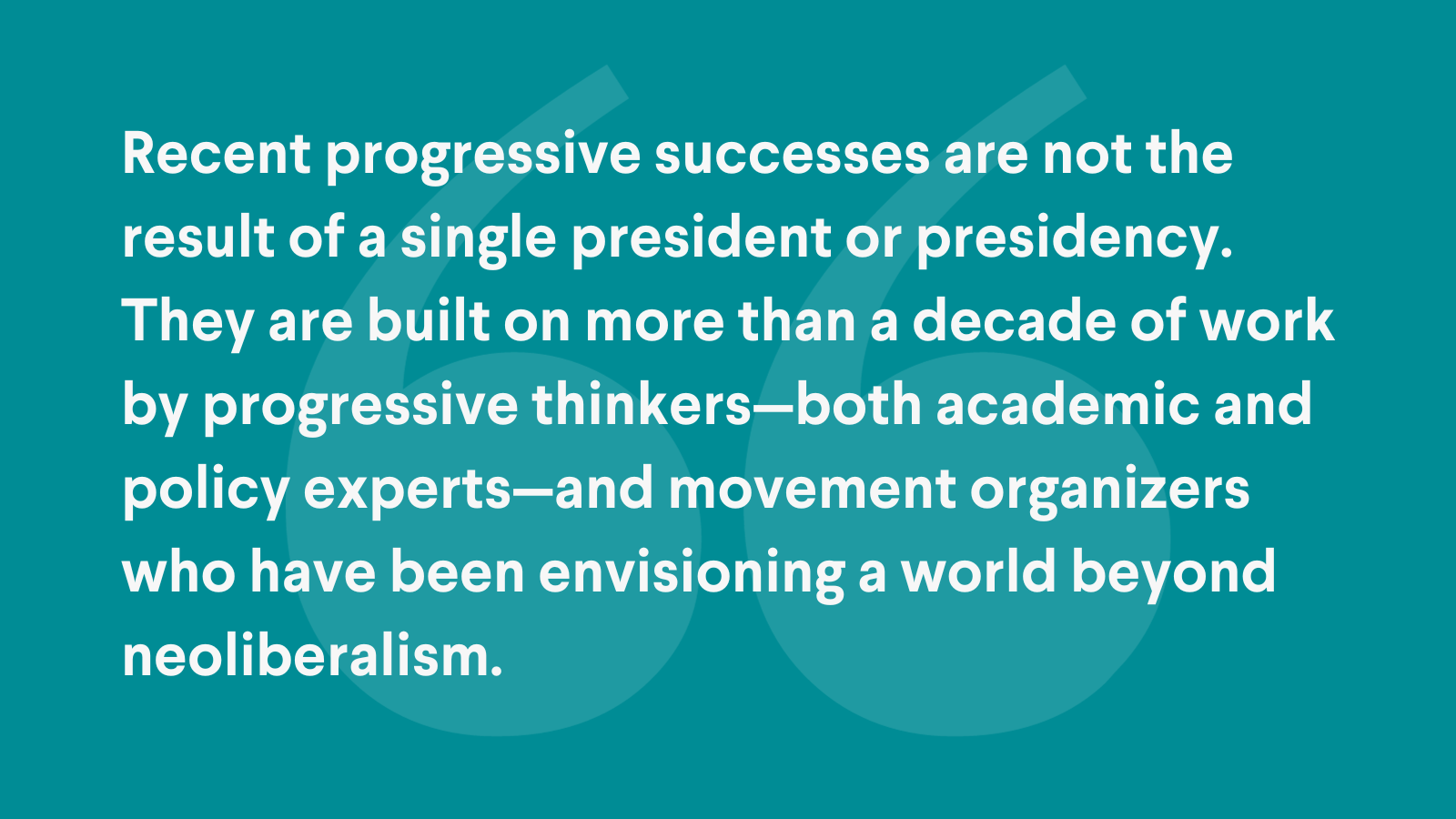
Inspired in part by the Black Lives Matter movement’s launch in 2013 and by the importance of reparations-focused work from Ta-Nehisi Coates (2014) and others, many of us discarded the neoliberal notions that economic inequalities and racial inequalities are only tangentially related, and that well-functioning markets would compete racism away (Becker 1971). Over the past decade, policy thinkers have increasingly recognized that we need more holistic analyses of racial gaps: in wealth, most importantly, but also in income, health, education, criminal justice outcomes, jobs, and occupational segregation (Flynn et al. 2017).
The years between 2008 and 2016 were about stocking the shelves with very new ideas: what was wrong with neoliberalism’s financialized economy, and what better economic alternatives might look like, on everything from taxing the wealthy to regulating companies with too much market power.
For the center-left, the shock of Donald Trump’s 2016 election victory pushed these ideas from the fringes to the mainstream. Of course, Trump’s mobilizing rhetoric in the 2016 election also parted ways with neoliberalism: Part of his appeal was to right-wing populism. The urgency of defining a progressive, post-neoliberal vision was thrown into stark relief by the illiberal, authoritarian version being spelled out as an alternative.
The arrival of the COVID-19 pandemic in what turned out to be the final year of Trump’s presidency made clear that neoliberal policies had left the nation wildly unprepared to meet a national crisis. Further, the upwelling of activism in response to the murder of George Floyd that summer laid bare how many crises we faced.
At the Roosevelt Institute, we had both a front-row seat to, and often a real role in, the crumbling of the neoliberal paradigm. Nevertheless, even we could not have imagined how quickly things would move.

Three years later, we have seen remarkable shifts in policymaking approaches in some areas, and notable retrenchment in others. Landmark legislation—the American Rescue Plan (ARP), the Infrastructure Investment and Jobs Act (IIJA), the CHIPS and Science Act, and the Inflation Reduction Act (IRA)—holds the promise not just of important investments but of a real and lasting shift in how the government views its role.
The Biden administration has taken to calling this shift “Bidenomics” (Biden 2023). Leaving aside the debate as to whether Bidenomics is an effective campaign slogan, the new approach itself is significant. It is policymaking with the North Star of rebalancing power in the economy by fostering the industries we need and supporting workers’ demands for higher wages and more economic security. This is a marked contrast with neoliberalism’s core propositions that the government should intervene as little as possible in markets and that resulting power differentials are both natural and a sign of innovation. Instead, Biden-era policies reflect a willingness to marshal public investments to shape markets toward greater equity.
Whether or not this new approach marks a long-lasting shift remains to be determined, and whether this shift goes far enough depends on the outcome of politics and policy fights ahead. The ideas behind Bidenomics are being contested by powerful actors driven to defend the primacy of the private sector.
Nevertheless, the new openness to public investment has already led to real results for the American people: The American Rescue Plan, passed less than two months after President Biden took office, represented a sharp break from how the government had responded to past recessions. Rather than worrying about spending too much—as policymakers did when they crafted a response to the Great Recession—in 2021, policymakers decided that going too small was a bigger risk. They prioritized getting money in people’s pockets and workers back into jobs instead of stabilizing the financial sector. This bet paid off, leading to the strongest labor market in decades (Ryckman 2023) and helping to put a dent in racial and economic inequality (Leonhardt 2023). The ARP also managed to push child poverty to a record low in 2021 through a robust Child Tax Credit (CTC)—though the tragic end of the CTC expansion in 2022 erased that progress, more than doubling child poverty within a year (Center on Budget and Policy Priorities 2023).
The Inflation Reduction Act and the CHIPS and Science Act have also led to a true boom in manufacturing investments. Investment in construction of manufacturing facilities doubled in the last two years; in the prior four years it had increased only 2 percent (Sheidlower 2023). These investments are directed toward critical industries for a decarbonized US, and, while by no means sufficient, set us on a real path toward meeting climate goals.
Further, the administration has shown an eagerness to use federal power to curb corporate power and boost worker power. The Federal Trade Commission, under Commissioner Lina Khan, has shown a willingness to challenge corporate concentration through lawsuits against Amazon and other megacorporations (Sorkin et al. 2023). President Biden himself has walked picket lines with workers empowered to fight for their rights by a hot labor market (Rogers and Green 2023).
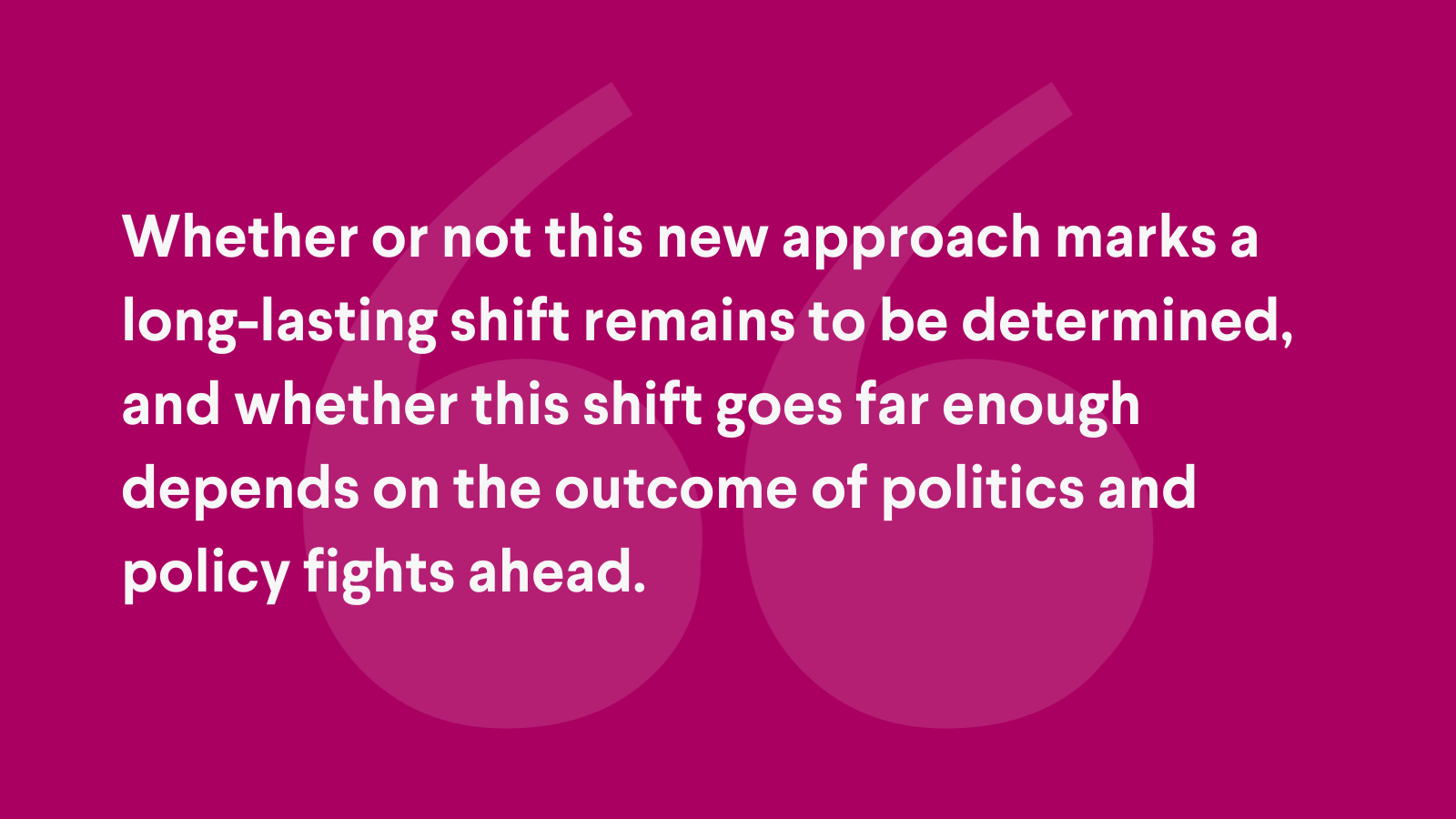
If we want these recent policy wins to truly reset our governing paradigm instead of serving as exciting, but limited, one-off investments and actions, it is critical that we understand how they came to be and what remains to be done. We must keep foremost in mind that this is not a fight over individual policies. It is a contest for a new mindset—the idea that democratic governance must structure our economy toward the public good. Otherwise, private, profit-seeking actors operating in unconstrained markets will exacerbate economic and racial inequalities simply by doing what they are designed to do best.
This report attempts to begin the project of understanding how we came to this moment. Recent progressive successes are not the result of a single president or presidency. They are built on more than a decade of work by progressive thinkers—both academic and policy experts—and movement organizers who have been envisioning a world beyond neoliberalism.2 In the following pages, we seek to offer an analysis of the people, institutions, and history that brought us to this moment in economic policymaking. We look at what has been accomplished and what remains to be done if we are to see a sustained transition toward more progressive economic governance.
While by no means exhaustive, we have attempted to pick examples that are illustrative of the potential of the new economics and in which we at Roosevelt were directly involved enough to have a unique perspective. Our hope is that these examples can provide both hopeful lessons and clarity about where we still need to push beyond neoliberal thinking to truly transform our economy.
That so many people—more than just academics—are questioning the abstract idea of neoliberalism is a testament to both its power and its material and cultural failures. But moving beyond neoliberalism will not guarantee a more progressive and democratic economic order or a more racially equitable one; for that, we must not only transform the economy but rebalance power within it.
When the Biden administration began its Bidenomics tour in the summer of 2023 (Viser and Wootson Jr.), it defined its economic framework with three pillars: empower and educate workers, invest in America, and promote competitive markets (The White House Press Briefing Room 2023b). The framework is a useful one. The three elements together focus on the core real-world legislative and regulatory achievements in the first years of the Biden presidency. Nevertheless, as we will explore below, without a robust commitment to democratic governance structures, these pillars will be insufficient to move us toward a truly progressive, post-neoliberal economy.
In the following sections, we explore each pillar, drawing on Roosevelt research and analysis to tell the story of progress, in progress.
Footnotes
Read the footnotes
1Occupy Wall Street’s slogan, “We are the 99 percent,” called attention to how extreme inequality had become and drew directly from work by Roosevelt Chief Economist Joseph Stiglitz (2011).
2To that end, this report builds on Roosevelt’s January 2020 report, The Emerging Worldview: How New Progressivism Is Moving beyond Neoliberalism (Wong 2020a). There, we argued that four groups of thinkers had begun to articulate organizing principles for a progressive, post-neoliberal ideology. “New structuralists” are those focused on government’s role in setting guardrails and rules for the market, and punishing bad private actors who breached those rules. “Public providers” prioritize increased state action—providing more public goods and utilizing debt as a government investment vehicle—and the idea that government can and should be a market actor in some cases. “Economic transformers” look to deploy government to catalyze large-scale economic change, create good jobs and new industries, and/or decarbonize the economy. And “economic democratists” seek to build democratic institutions to ensure that government is up to the tasks identified above.
Sea Change: Key Themes
Empower and Educate Workers
In the last three years, we have seen a transformed approach to government involvement in labor markets—not only in fiscal policy, but through a wide range of policy levers including workforce development and education policy.
The radically different responses to the Great Recession and COVID-19 downturn show what that transformation has meant for workers.
Invest in America
The shift away from neoliberal policies and toward a more affirmative role for government has been perhaps the most visible in the Biden administration’s approaches to national crises—some long-standing and some new.
From the COVID pandemic, to the climate crisis, to the supply-chain crisis, we have seen a new willingness to contemplate and deploy solutions that center public interventions in the market.
Promote Competition
Neoliberalism isn’t just a negative call for smaller government. Its framing of markets as apolitical and ahistorical sites for the expression of individual freedom actually offers an affirmative vision for government policies that structure markets to maximize individual returns, efficiency, and choice while minimizing costs (Kahn 2022).



